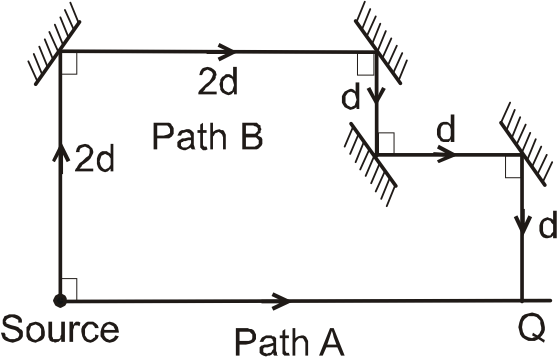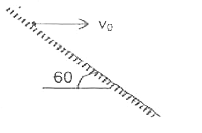A sound wave of wavelength λ travels towards the right horizontally with a velocity V. It strikes and reflects from a vertical plane surface , travelling at a speed v towards the left . The number of positive crests striking in a time interval of 3s on the wall is
3(V+v)/λ
3(V−v)/λ
(V+v)/3λ
(V−v)/3λ
The correct Answer is:A
To solve the problem, we need to determine the number of positive crests of a sound wave that strike a vertical plane surface in a time interval of 3 seconds. Here’s how we can approach the solution step by step:
Step 1: Understand the given parameters
- Wavelength of the sound wave: λ
- Velocity of the sound wave: V
- Velocity of the vertical plane surface: v
- Time interval: t=3s
Step 2: Determine the relative velocity of the sound wave with respect to the wall
When the sound wave strikes the wall, it travels towards the wall at speed V, while the wall is moving towards the sound wave at speed v. Therefore, the relative velocity Vrel of the sound wave with respect to the wall is given by:
Vrel=V+v
Step 3: Calculate the frequency of the sound wave
The frequency f of the sound wave can be calculated using the formula:
f=Vλ
However, since the wall is moving towards the sound wave, the apparent frequency f′ that the wall perceives will be:
f′=Vrelλ=V+vλ
Step 4: Calculate the number of crests striking the wall in 3 seconds
The number of crests striking the wall in one second is equal to the apparent frequency f′. Therefore, in 3 seconds, the total number of crests N striking the wall will be:
N=f′×t=(V+vλ)×3
Final Expression
Thus, the total number of positive crests striking the wall in 3 seconds is:
N=3(V+v)λ
Summary
The number of positive crests striking the wall in a time interval of 3 seconds is given by:
N=3(V+v)λ
---
- Wavelength of the sound wave: λ
- Velocity of the sound wave: V
- Velocity of the vertical plane surface: v
- Time interval: t=3s
When the sound wave strikes the wall, it travels towards the wall at speed V, while the wall is moving towards the sound wave at speed v. Therefore, the relative velocity Vrel of the sound wave with respect to the wall is given by:
Vrel=V+v
The frequency f of the sound wave can be calculated using the formula:
f=Vλ
However, since the wall is moving towards the sound wave, the apparent frequency f′ that the wall perceives will be:
f′=Vrelλ=V+vλ
The number of crests striking the wall in one second is equal to the apparent frequency f′. Therefore, in 3 seconds, the total number of crests N striking the wall will be:
N=f′×t=(V+vλ)×3
Thus, the total number of positive crests striking the wall in 3 seconds is:
N=3(V+v)λ
The number of positive crests striking the wall in a time interval of 3 seconds is given by:
N=3(V+v)λ
Topper's Solved these Questions
- BOOK - CENGAGE PHYSICSCHAPTER - SUPERPOSITION AND STANDING WAVESEXERCISE - Multiple26videos
SUPERPOSITION AND STANDING WAVES
- BOOK - CENGAGE PHYSICSCHAPTER - SUPERPOSITION AND STANDING WAVESEXERCISE - Assertion - Reasoning6videos
SUPERPOSITION AND STANDING WAVES
- BOOK - CENGAGE PHYSICSCHAPTER - SUPERPOSITION AND STANDING WAVESEXERCISE - Subjective24videos
SUPERPOSITION AND STANDING WAVES
- BOOK - CENGAGE PHYSICSCHAPTER - SOUND WAVES AND DOPPLER EFFECTEXERCISE - Integer16videos
SOUND WAVES AND DOPPLER EFFECT
- BOOK - CENGAGE PHYSICSCHAPTER - THERMODYNAMICSEXERCISE - 241videos
THERMODYNAMICS
Similar Questions
A sound wave of frequency f travels horizontally to the right . It is teflected from a larger vertical plane surface moving to left with a speed v. the speed of sound in medium is c
(a) The number of waves striking the surface per second is f(c+υ)c
(b) The wavelength of reflected wave is c(c−υ)f(c+υ)
(c) The frequency of the reflected wave is f((c+υ))(c+υ)
(d) The number of beats heard by a stationary listener to the left of the reflecting surface is υfc−υView SolutionThe frequency of a source of sound is f. A sound wave from this source is moving horizontally twoards right. The wave is reflected from a large vertical plane moving towards left with a speed v.
The speed of sound in medium is C. Find the
(a) number of waves striking the surface per second.
(b) Wavelength and frequency of reflected wave.
(c) beat frequency.View Solution
Knowledge Check
- Question 1 - Select One or More
A sound wave of frequency f travels horizontally to the right. It is reflected from a large vertical plane surface moving to left with a speed v. The speed of sound in mwdium is C
A(a) The number of wave strinking the surface per second is f(c+vc)B(b) The wavelength of reflected wave is c(c−v)f(c+v)C( c ) The frequency of the reflected wave is f((c+v)(c−v))D(d) The number of beats heard by a stationary listener to the left if the reflecting surface is vfc−v - Question 2 - Select One
A sound wave of frequency v travels horizontally to right. It is reflected from a large vvertical plane surface moving to the left with a speed v. The speed of sound in the medium is c, then
Athe frequency of the reflected wave is v(c+v)c−vBthe wavelength of the reflected wave is c(c−v)v(c−v)Cthe number of waves striking the surface per second is v(c−v)cDthe number of beats heard by a stationary listener to the left of the reflecting surface, is ∨c−v - Question 3 - Select One

A sound wave of frequency n travels horizontally to the right with speed with speed c. It is reflected from a broad wall moving to the left with speed v. The number of beats heard by a stationary observer to the left of the wall isAzeroBn(c+v)c−vCnvc−vD2nvc−v
A sound wave of frequency f propagasing through air with a velocity C, is reflected from a surface which is moving away from the source with a constant speed V. Find the frequency of the reflected wave, measured by the observer at the position of the source.
View SolutionA stationary source emits a sound towards a wall moving towards it with a velocity u. speed of sound in in air = v. Find the fractional change in wavelength of the sound sent and the reflected sound.
View SolutionA sound source emits two sinusoidal sound waves, both of wavelength λ, along paths A and B as shown in figure.The sound travelling along path B is reflected from five surfaces as shown and then merges at point Q, producing minimum intensity at that point.The minimum value of d in terms of λ is :
 View Solution
View SolutionA ball is projected horizontally from an inclined plane with a velocity V, as shown in the figure. It will strike the plane after a time
 View Solution
View SolutionA sound wave of frequency f propagasing through air with a velocity C, is reflected from a surface which is moving away from the source with a constant speed V. Find the frequency of the reflected wave, measured by the observer at the position of the source.
View Solution

